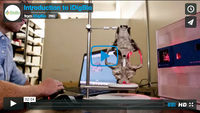Digitization Resources: Difference between revisions
| Line 24: | Line 24: | ||
|style="vertical-align:top;"|[[File:PlayVideo2.jpg|thumb|200px|link=https://vimeo.com/67570758]] | |style="vertical-align:top;"|[[File:PlayVideo2.jpg|thumb|200px|link=https://vimeo.com/67570758]] | ||
|rowspan="1" colspan="2" style="vertical-align:top"|More than 1,600 natural history collections across the United States house over 1 billion biological specimens ranging from fungi to fish to fossils. This video describes the iDigBio project. It explains why digitized information and ready access to it are important, provides an overview of the digitization process and highlights some of the challenges faced when working with different types of natural history collections. | |rowspan="1" colspan="2" style="vertical-align:top"|More than 1,600 natural history collections across the United States house over 1 billion biological specimens ranging from fungi to fish to fossils. This video describes the iDigBio project. It explains why digitized information and ready access to it are important, provides an overview of the digitization process and highlights some of the challenges faced when working with different types of natural history collections. | ||
|} | |} | ||
Revision as of 14:13, 2 May 2016
| Digitizing the Past and Present for the Future | |
|---|---|
| Digitization | |
| How to digitize? (Five clusters) | Workshops and Symposia |
| Digitization Videos | Biblio entries |
| Connect with iDigBio | |
| Specimen Portal | Upcoming Events |
| iDigBio on facebook | Follow iDigBio on twitter |
This page provides resources and information for the series of digitization training workshops being conducted by iDigBio as well as a plethora of digitization information and resources. Included is a growing list of links to documents, websites, videos, presentations, and other important information related to biological collection digitization.
iDigBio Introduction
| More than 1,600 natural history collections across the United States house over 1 billion biological specimens ranging from fungi to fish to fossils. This video describes the iDigBio project. It explains why digitized information and ready access to it are important, provides an overview of the digitization process and highlights some of the challenges faced when working with different types of natural history collections. | ||
Recommendations for the Acquisition, Processing, and Archiving of Digital Media
iDigBio has created recommendations for capturing, processing, and storing digital media.
Recommendations for the Acquisition, Processing, and Archiving of Digital Media
Interest/Working Groups
The following links take you to Interest/Working Groups focused on Digitization. For other working groups please use the following link iDigBio Working Groups
- International Whole-Drawer Digitization Interest Group
- NANSH Working Group (North American Network of Small Herbaria)
- Fluid-preserved Arthropod and Microscopic Slide Imaging Interest Group
- Paleontology Digitization Working Group
- Small Collections Network Working Group
- Vertebrate Digitization Intererst Group
- Field Station Interest Group
Digitization Avenue
The following links provide information on the task clusters that enable efficient and effective digitization of Biological and Paleontological Collections. If you are unfamiliar with the task clusters please read the following Five task clusters that enable efficient and effective digitization of biological collections.
- Pre-digitization Curation and Staging
- Specimen Image Capture
- Specimen Image Processing
- Electronic Data Capture
- Georeferencing Locality Descriptions
- Digitization Workflows and Protocols
- More on digitization
iDigBio Workshops, Reports, and Wikis
iDigBio's Workshop and Report page contains links to materials from completed iDigBio workshops, conferences, and symposia.

